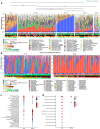Gut virome and microbiome dynamics before and after SARS-CoV-2 infection in women living with HIV and their infants
- PMID: 39185682
- PMCID: PMC11352790
- DOI: 10.1080/19490976.2024.2394248
Gut virome and microbiome dynamics before and after SARS-CoV-2 infection in women living with HIV and their infants
Abstract
Microbiome perturbations can have long-term effects on health. The dynamics of the gut microbiome and virome in women living with HIV (WLHIV) and their newborn infants is poorly understood. Here, we performed metagenomic sequencing analyses on longitudinal stool samples including 23 mothers (13 WLHIV, 10 HIV-negative) and 12 infants that experienced SARS-CoV-2 infection with mild disease, as well as 40 mothers (18 WLHIV, 22 HIV-negative) and 60 infants that remained SARS-CoV-2 seronegative throughout the study follow-up. Regardless of HIV or SARS-CoV-2 status, maternal bacterial and viral profiles were distinct from infants. Using linear mixed effects models, we showed that the microbiome alpha diversity trajectory was not significantly different between SARS-CoV-2 seropositive and seronegative women. However, seropositive women's positive trajectory while uninfected was abruptly reversed after SARS-CoV-2 infection (p = 0.015). Gut virome signatures of women were not associated with SARS-CoV-2. Alterations in infant microbiome and virome diversities were generally not impacted by SARS-CoV-2 but were rather driven by development. We did not find statistically significant interactions between HIV and SARS-CoV-2 on the gut microbiome and virome. Overall, our study provides insights into the complex interplay between maternal and infant bacterial microbiome, virome, and the influence of SARS-CoV-2 and HIV status.
Keywords: HIV; SARS-CoV-2; bacterial microbiome; gut; longitudinal; mothers and infants; virome.
Conflict of interest statement
No potential conflict of interest was reported by the author(s).
Figures





Update of
-
Gut virome and microbiome dynamics before and after SARS-CoV-2 infection in women living with HIV and their infants.Res Sq [Preprint]. 2024 Apr 17:rs.3.rs-4257515. doi: 10.21203/rs.3.rs-4257515/v1. Res Sq. 2024. Update in: Gut Microbes. 2024 Jan-Dec;16(1):2394248. doi: 10.1080/19490976.2024.2394248. PMID: 38699305 Free PMC article. Updated. Preprint.
References
-
- Kaelin EA, Rodriguez C, Hall-Moore C, Hoffmann JA, Linneman LA, Ndao IM, Warner BB, Tarr PI, Holtz LR, Lim ES, et al. Longitudinal gut virome analysis identifies specific viral signatures that precede necrotizing enterocolitis onset in preterm infants. Nat Microbiol. 2022;7(5):653–15. doi: 10.1038/s41564-022-01096-x. - DOI - PMC - PubMed
-
- Wagner J, Maksimovic J, Farries G, Sim WH, Bishop RF, Cameron DJ, Catto-Smith AG, Kirkwood CD. Bacteriophages in gut samples from pediatric Crohn’s disease patients: metagenomic analysis using 454 pyrosequencing. Inflamm Bowel Dis. 2013;19(8):1598–1608. doi: 10.1097/MIB.0b013e318292477c. - DOI - PubMed
MeSH terms
Grants and funding
LinkOut - more resources
Full Text Sources
Medical
Miscellaneous
